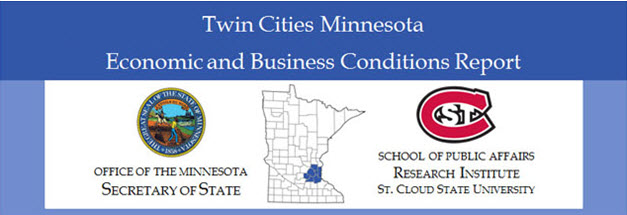Document Type
Research Study
Publication Date
12-20-2016
Abstract
A slower pace of economic growth is expected over the next several months in the Twin Cities according to the prediction of the St. Cloud State University Twin Cities Index of Leading Economic Indicators (LEI). The Twin Cities LEI fell 5.70 points in the third quarter after a nearly neutral reading in the previous quarter. Four of the five index components decreased in the third quarter. Lower initial claims for unemployment insurance were the only index component that had a positive impact on this quarter’s LEI. Weakness in two general measures of statewide business conditions had a negative effect on the index. Slowing of residential building permits in the Twin Cities MSA and a decline in new filings of business incorporation and LLC also weighed on the Twin Cities LEI.
There were 9,196 new business filings with the Office of the Minnesota Secretary of State in the seven-county metro area in the third quarter of 2016—representing a 5 percent decrease from one year ago. There were 1,299 new regional business incorporations in the third quarter, a 3.7 percent decrease over year ago levels. Third quarter new LLC filings fell to 5,570 in the seven-county metro area—a 7.3 percent decrease compared to the third quarter of 2015. New assumed names totaled 1,927 in the third quarter. This was 0.5 percent lower than one year ago. There were 400 new filings for non-profit in the Twin Cities in the third quarter of 2016, 2.3 percent more filings than one year earlier.
Twin Cities employment decreased by 0.4 percent over the year ending September 2016. At 3.2 percent, the planning area’s unemployment rate was slightly higher than one year earlier. Initial claims for unemployment insurance were lower than year ago levels, falling by 7.3 percent to 6,140. The job vacancy rate in the Twin Cities planning area was 96.27 per 100 unemployed—the highest rate of Minnesota’s six planning areas. The planning area labor force contracted by 0.2 percent over the year ending in September 2016. Annual bankruptcies continued to decline in the Twin Cities over the past twelve months. Average weekly hours and average hourly earnings were both higher in the metro area and the relative cost of living declined.
Recommended Citation
Banaian, King and MacDonald, Richard A., "Twin Cities Minnesota Economic and Business Conditions Report - Third Quarter 2016" (2016). Twin Cities Minnesota Economic and Business Conditions Report. 11.
https://repository.stcloudstate.edu/qebcr_tc_mn/11




